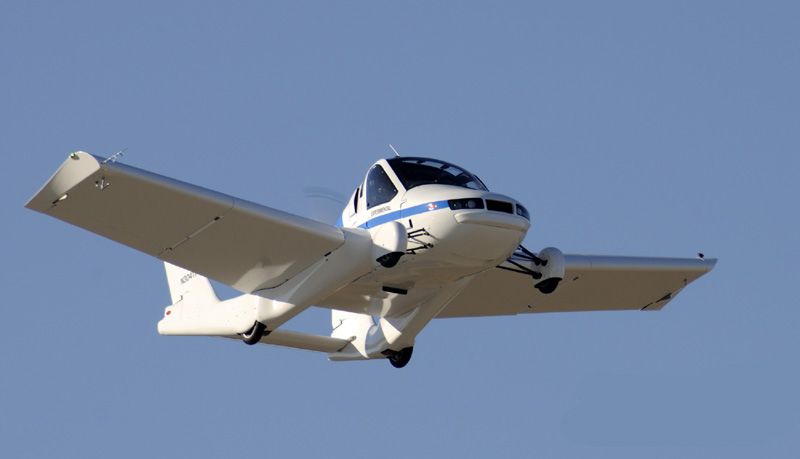Yet Another Flying Car
Here we go again.
/https://tf-cmsv2-smithsonianmag-media.s3.amazonaws.com/filer/4f/80/4f806029-b572-4a25-8a2d-bbd47bddeb2b/aeromobil3.jpg)
The Slovakian company AeroMobil unveiled the latest version of its experimental flying car, dubbed AeroMobil 3.0, today at the Vienna Pioneers Festival, becoming the latest company to chase a dream that hasn’t yet worked out for anyone.
The history of flying cars is long and storied—and full of hype. The first practical cars and aircraft came onto the market at roughly the same time, in the first decade of the 20th century, and combining the two seemed a natural. The idea has haunted futurists’ dreams ever since, and flying cars have become a staple of science fiction stories. But “Where’s my flying car?” also has become a mocking way to point out the difference between technological promise and reality.
Several prominent flying cars have been built and flown, but they all ended up combining the worst qualities of a car with the worst qualities of an airplane—they were slow, impractical and expensive in the air, as well as on the ground. Despite the press coverage that accompanies the launch of each new design, only a couple of flying cars (The Airphibian and Aerocar) have won certification from the relevant authorities, and none have been produced in volume.
And yet the dream persists. One of the most recent—and most advanced—contenders is Terrafugia (Latin for “escape from the land”) with its experimental Transition model. The craft advertises good fuel economy on the ground (35 miles per gallon) and in the air (five gallons per hour) and runs on regular unleaded gasoline rather than the expensive, leaded avgas most light aircraft use. It becomes airworthy with little more than the push of a button. But at a price of $279,000, it’s a very pricy ride.

There is a saying in aviation that if it looks good, it will fly good, and the Transition is both an ungainly-looking aircraft and an awkward car. The company probably knows it—the successor product, a vertical-takeoff-and-landing, hybrid electric vehicle called TF-X, looks much slicker, but is for now just an impressive digital simulation. Transition production doesn’t officially start until 2016, and TF-X is at least eight years away from being developed.
Enter AeroMobil. Like Terrafugia, AeroMobil’s craft is in prototype stage. And though it does look pretty weird, the staff of former car designers managed to make it look like a cross between a sleek concept sports car and an exotic if odd prototype airplane. Performance on paper is similar for both aircraft—they both use the same engine and weigh about the same—and while neither price nor production schedule has been announced, the two are likely to be roughly comparable in those areas as well.
Which still doesn’t help much. Neither AeroMobil nor Terrafugia solve some fundamental problems with the flying car business model. For one thing, they are essentially selling an airplane with stupendous taxiing characteristics. Takeoff and landing are confined to the usual areas, and compliance with FAA regulations—including an active pilot’s license and medical certificate—is mandatory. Both flying cars are eligible for “light sport aircraft” certification. Licenses in that category are easier to obtain than most pilot’s licenses, but come with all sorts of restrictions that make flexible business trips difficult. There are plenty of qualified pilots out there, but that alone doesn’t mean that swarms of Terrafugias will darken the skies.
The marriage of airplane and car creates inherent problems that will be hard for anyone to resolve. Car crash standards, for example, incline manufacturers toward building heavier vehicles, whereas airplane designers try to shed as much weight as possible.
Then there’s the cost. The price of Terrafugia’s Transition is about the same as a brand-new Cessna 172, with about half the range. An old, used 172 costs about a third of a new one (based on a quick browse of Trade-A-Plane), which leaves you enough to buy both the airplane and two excellent cars (one for either end of the trip). But you don’t even need them: Many airports provide a free “crew car” to pilots for a few hours—usually ancient rust-buckets, but functioning transportation nonetheless.
With all these drawbacks, the main appeal of flying cars continues to be the novelty—and novelty aircraft don’t usually sell very well. Which means we’ll probably keep hearing dissatisfied dreamers ask “Where are the flying cars?” far more than we’ll see them in the sky.
Here’s a video of AeroMobil’s previous (2.5) version in action.

